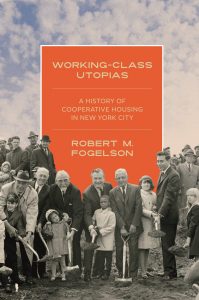Working-Class Utopias: A History of Cooperative Housing in New York City
 Working-Class Utopias: A History of Cooperative Housing in New York City by Robert M. Fogelson (Princeton: Princeton University Press, 2022)
Working-Class Utopias: A History of Cooperative Housing in New York City by Robert M. Fogelson (Princeton: Princeton University Press, 2022)
The lack of decent and affordable housing is a persistent problem for working-class Americans. In many cities, exorbitant rents and mortgages price workers out of housing, forcing them to make long commutes to and from work and live in substandard conditions. This issue is hardly exclusive to urban areas since working-class people in suburban and rural communities face similar circumstances. So, what can be done? As historian Robert M. Fogelson tells us in Working-Class Utopias, the story of cooperative housing in New York City is a cautionary example of how unions and their allies tried to deal with this problem.
Fogelson, a professor emeritus at MIT, has studied urban affairs since the 1960s. In Working-Class Utopias he describes how Abraham Kazan of the Amalgamated Clothing Workers of America (ACWA) and, later, Harold Ostroff of the United Housing Federation (UHF), attempted to build affordable housing in New York City from the 1930s to the 1970s. Their vision, moreover, was a national one as they saw transformative potential in bypassing landlords who were only motivated by profit. Unfortunately, it did not come to pass. The fate of cooperative housing, Fogelson argues, was intimately connected with the state of the labor movement in general, and the needle trades unions in particular, in the latter decades of the 20th century.
Working-Class Utopias begins in the first half of the 19th century. Slums were harsh and unpleasant places to live. Critics saw them as breeding grounds for vice, criminality, and civil unrest that posed threats to public health and safety. Progressive era reformers implemented measures to improve housing stock from enacting building codes that required windows in new tenements to encouraging people to relocate to single-family homes outside the city proper. During a housing shortage in the aftermath of World War I, the ACWA and the International Ladies Garment Workers Union (ILGWU) began exploring cooperative housing as an alternative to renting and public housing.
Cooperative housing was based on a simple idea: residents paid a one-time payment for an apartment (for example, $500 per room in the Amalgamated Houses in 1927) and then a fixed amount per room each month for utilities. As Fogelson writes, “cooperative housing was designed to build homes for people rather than to generate profits for investors.” (40) Thus, in spite of the postwar Red Scare and conservative drift of the 1920s these projects extended the work of the unions outside of the workplace and into the community. By the early 1930s, the ACWA had built three properties that housed more than 850 working-class families, but the Great Depression and World War II brought construction to a halt.
Kazan was indefatigable in these pursuits. Attempts to enact federal legislation after WWII to promote cooperative housing failed, so where projects did succeed it was due to local efforts. Fogelson offers a thorough account of Kazan’s work to secure land, financing, and other support in New York City from city, state, and federal lawmakers, local and state agencies, banks and insurance companies, and, of course, unions. This account brings into sharp relief a contradiction: for all of Kazan’s belief in the “collective self-help” of cooperative housing, they were based in a political and economic context that was hardly conducive to cooperative enterprises.
In 1951, cooperative housing advocates organized the UHF to facilitate additional projects and promote their mission. By and large, the fortunes of the UHF paralleled the labor movement in the postwar period. By 1964, it had sponsored or co-sponsored the construction of 23 housing cooperatives in New York City (with the exception of Staten Island). Fogelson cites several figures that reveal the human dimension of these accomplishments: to wit, they housed more than 100,000 people for an average of $490 per room and an average of $19 per month in utility fees (also known as “carrying charges”).
The UHF fell on hard times by the early 1970s. Fogelson devotes several chapters to the construction of the massive Co-Op City housing cooperative in the Bronx in the mid to late 1960s. This project experienced several hurdles getting off the ground and things only got more challenging when the project was complete. Inflationary pressures of the early 1970s required co-op leaders to increase carrying charges, which culminated in a “rent strike” (against carrying charges) by residents in 1975-1976.
Robert Fogelson deserves recognition for Working-Class Utopias. It is the product of deep and extensive research in primary and secondary sources, which he synthesizes elegantly. Readers interested in New York City history will find much to enjoy in this book. A great deal of working-class life occurs outside of the workplace, yet most labor histories tend to focus on workplace relations. Fogelson’s work reminds us that workers have often struggled to find good, affordable housing in their communities, and that’s a topic which deserves the attention of scholars and organizers.
Reviewed by John Lepley, a labor educator in Pittsburgh, Pennsylvania.
